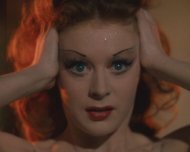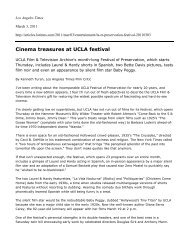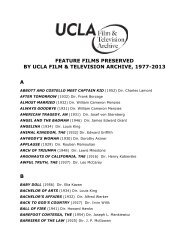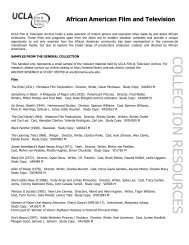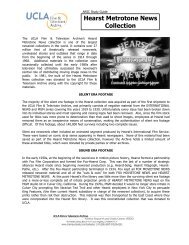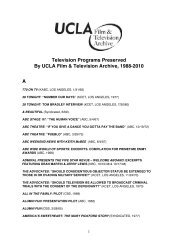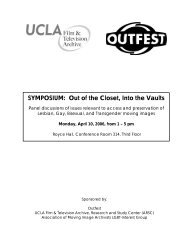"Heroic Grace" catalog - UCLA Film & Television Archive
"Heroic Grace" catalog - UCLA Film & Television Archive
"Heroic Grace" catalog - UCLA Film & Television Archive
You also want an ePaper? Increase the reach of your titles
YUMPU automatically turns print PDFs into web optimized ePapers that Google loves.
LI FEIFEI, 1925], and which would later become Hong Kong’s Shaw<br />
Brothers), Mingxing, Xifan, Youlian (known for its prodigious output<br />
of nüxia or “female knight-errant” films), Yueming and others churned<br />
out one swordplay fantasy after another.<br />
The frenzy reached a peak in 1927-1931 when over 200 films were<br />
produced. Production in those four years alone accounted for about half<br />
of the estimated total of 400 martial arts films made in China in all<br />
the years prior to the Communist Revolution of 1949. 2 Audiences were<br />
apparently enthralled by this newfangled hybrid that could embody<br />
modernity (technology and speed, comic books, popular novels and serialized<br />
newspaper stories) and folkloric culture (traditional opera and<br />
acrobatics). 3 Martial arts movies not only imagined but also shockingly<br />
“manifested” gravity-defying warriors in the face of China’s occupation<br />
by foreign powers. 4 (Exported to Southeast Asia, the martial arts film<br />
captured the imagination of the Chinese diasporic communities as well, a<br />
condition lasting well into the ’80s.)<br />
Although politically at odds, ruling Nationalists on the right and May<br />
Fourth intellectuals on the left united in their disapproval of the genre’s<br />
alleged vulgarity and sensorial assaults. Martial arts films were thought<br />
capable of unleashing anarchy and uncontrollable passions among the<br />
masses. 5 In 1931 government censors banned a number of martial arts<br />
titles. Successive bans in the early ’30s and the ascendancy of May<br />
Fourth-influenced social melodrama ensured the genre’s decline. 6 By<br />
1937 China was at war with Japan, and the genre’s Shanghai epoch was<br />
effectively over. After the Revolution, martial arts films were again<br />
deemed ideologically suspect and destroyed. Of the few titles that have<br />
survived, <strong>Heroic</strong> Grace will present two: RED HEROINE (HONG XIA, 1929) and<br />
SWORDSWOMAN OF HUANGJIANG (HUANGJIANG NÜXIA, 1930), silents that<br />
prove that woman warriors were battling from the early days of the<br />
cinematic jiang hu.<br />
From the war-torn period of the late ’30s through World War II and the<br />
Revolution and its aftermath, Hong Kong became the principal beneficiary<br />
of film talent and capital fleeing Shanghai. The then-British colony<br />
had a local film industry, which had produced its first Cantonese martial<br />
arts film, THE ADORNED PAVILION (FAN TSONG LAU/FENZHUANG LO), in 1938. 7<br />
It would be this Cantonese cinema that would keep the arsenal of supranormal<br />
prowess, the mystical realms, the strange and uncanny habitues<br />
of the silent shenguai wuxia pian alive. 8 From the 1950s onwards, “sword<br />
and sorcery” took flight in such Cantonese serials as THE SIX-FINGERED<br />
LORD OF THE LUTE (LOKE CHI KAM MOH/LIU ZHI QIN MO,1965) and SACRED<br />
FIRE, HEROIC WIND (SING FENG HUNG FONG/SHENGHUO XIONGFENG,1966),<br />
connoting magic via hand-drawn special effects and animation (another<br />
echo of their silent antecedents).<br />
2 Estimates provided by the China <strong>Film</strong> <strong>Archive</strong>, Beijing. See also Zhang Zhen, “Bodies<br />
in the Air: The Magic of Science and the Fate of the Early ‘Martial Arts’ <strong>Film</strong> in China,”<br />
Postscript, 20, Nos. 2-3 (Winter/Spring-Fall 2001), 44.<br />
3 Zhang, 44-52. For a discussion of modernity, Shanghai urban culture and Chinese<br />
cinema of the ’20s to ’40s, see Leo Lee Ou-fan, Shanghai Modern (Cambridge: Harvard<br />
UP, 1999), Ch. iii, pp. 82-119. Also, Zhang Yingjin, Introd., ed., Cinema and Urban<br />
Culture in Shanghai, 1922-1943 (Stanford UP, 1999), Ch. i, pp. 3-23.<br />
4 Zhang, 44-45, 51-52. Reception of martial arts cinema in the prewar republican<br />
period (1911-1937) in a sense replicated the popular response to the martial arts<br />
fiction that preceded it in the late Qing Dynasty (late 19th century-1911). As Ng Ho<br />
writes, “The popularity of the martial arts novels in the late Qing era could probably<br />
be attributed to the intense longing for superhuman heroes strong enough to resist<br />
foreign aggression and to counter the repression of the Manchu government.” Quoted<br />
in “Jiang Hu Revisited: Towards a Reconstruction of the Martial Arts World,” in A Study<br />
of the Hong Kong Swordplay <strong>Film</strong> 1945-1980, ed. Leong Mo-ling, rev. ed. (5th Hong<br />
Kong International <strong>Film</strong> Festival/Urban Council, 1981), p. 84.<br />
2<br />
While the “sorcery” would become less pronounced in the Mandarin<br />
“new school” wuxia pian—literally the “martial chivalry” film, commonly<br />
known as the swordplay film whose ascendancy in the mid-’60s was<br />
signaled by, among others, King Hu—Cantonese cinema was nurturing<br />
another more earth-bound strain of martial arts in the long-running<br />
WONG FEI-HUNG series. In about 80 episodes spanning 1949 to the early<br />
’70s, actor Kwan Tak-hing, an opera-trained martial arts exponent, came<br />
to personify the folk-hero apothecary who lived in Guangdong during the<br />
late 19th and early 20th century. The series itself subsumed supernatural<br />
valor to (relative) realism and a Confucianist ethos of social propriety<br />
and clan identity. Hong Kong film critic Sek Kei has noted how the<br />
close-quarter combat style deployed in WONG FEI-HUNG anticipated the<br />
kung fu fighting of the ’70s. 9<br />
But perhaps most significantly, the series helped reshape the postwar<br />
cinematic landscape of the jiang hu. Martial arts director Han Yingjie<br />
honed his craft on it and other shows before originating the vaunted<br />
“new school” somersaulting of King Hu’s COME DRINK WITH ME (DAI ZUI<br />
XIA,1966) and DRAGON INN (LONGMEN KEZHAN, 1968). The series also served<br />
as a crucible for a new generation of martial arts directors led by Lau<br />
Kar-leung (Liu Jialiang), Tong Kai (Tang Jia) and Yuen Wo-Ping (Yuan<br />
Heping). First in tandem with directors Zhang Che (Chang Cheh) and Chu<br />
Yuan (Chor Yuen), then as directors themselves, Lau et al. brought kinesthetic<br />
eloquence and force to the dance of combat. Whether with clawed<br />
“tiger” fists or limber “crane” legs, thwacking poles or clanging swords,<br />
in rhythmic pas de deux or soaring flight, sleight of editing or camera<br />
moves, the Hong Kong martial arts cinema of the ’60s and ’70s turned<br />
fighting—and all that implies about what is being fought over—into virtuosic<br />
expression. (For fuller discussions of the films from this period,<br />
please see the essays and program notes elsewhere in this <strong>catalog</strong>.) The<br />
celebrated “balletics” of such “action auteurs” today as Jackie Chan,<br />
Sammo Hung, Tsui Hark and John Woo can be seen as more recent inspirations<br />
radiating from that fount.<br />
Each cycle wanes and another is ushered in. Kung fu usurped the<br />
dominance of swordplay in the ’70s only to be supplanted itself by the<br />
“sword and sorcery” revival in the ’80s and ’90s. Cantonese gave way to<br />
Mandarin in the mid-’60s which in turn gave way to Cantonese in the late<br />
’70s. 10 In the mythic world of the jiang hu, the wheels of time have a way<br />
of revivifying what’s past. The martial arts film had a momentary rekindling<br />
in Mainland China in the early ’80s. Might legendary heroes and<br />
heroines awaken again with a vengeance in the place of their birth?<br />
Cheng-Sim Lim<br />
Curator, <strong>Heroic</strong> Grace: The Chinese Martial Arts <strong>Film</strong><br />
5 Zhang, 44-45, 55-56.<br />
6 Zhang, 45, 55-56.<br />
7 Yu Mo-wan, “Swords, Chivalry and Palm Power: A Brief Survey of the Cantonese<br />
Martial Arts Cinema, 1938-1970),” in Swordplay <strong>Film</strong>, p. 99.<br />
8 Yu, pp. 99-106.<br />
9 Sek Kei, “The Development of ‘Martial Arts’ in Hong Kong Cinema,” in Martial Arts<br />
<strong>Film</strong>, pp. 30, 32.<br />
10 Stephen Teo, Hong Kong Cinema: The Extra Dimensions (London: BFI Publishing,<br />
1997), pp. 97-109. See also Lau, p.3; and Yu, pp. 102-106. Sek Kei further argues that<br />
as Cantonese movies lost market dominance in Hong Kong to Mandarin movies,<br />
female stars and powerful heroines gave way to male stars and martial heroes; see<br />
“The War Between the Cantonese and Mandarin Cinemas in the Sixties or How the<br />
Beautiful Women Lost to Action Men,” in The Restless Breed: Cantonese Stars of the<br />
Sixties, ed. Stephen Teo (20th Hong Kong International <strong>Film</strong> Festival/Urban Council,<br />
1996), pp. 30-33.




